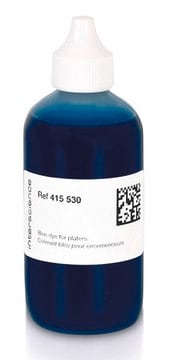About This Item
Polecane produkty
Postać
powder or crystals
skład
Dye content, 25%
mp
205 °C (dec.) (lit.)
λmaks.
654 nm
ε (współczynnik ekstynkcji)
≥12000 at 257-263 nm in water at 0.01 g/L
≥4500 at 289-295 nm in water at 0.01 g/L
≥45000 at 651-657 nm in water at 0.01 g/L
Zastosowanie
diagnostic assay manufacturing
hematology
histology
temp. przechowywania
room temp
ciąg SMILES
[Cl-].CCN(CC)c1ccc2nc3ccc(cc3[o+]c2c1)N(CC)CC
InChI
1S/C20H26N3O.ClH/c1-5-22(6-2)15-9-11-17-19(13-15)24-20-14-16(23(7-3)8-4)10-12-18(20)21-17;/h9-14H,5-8H2,1-4H3;1H/q+1;/p-1
Klucz InChI
IURGIPVDZKDLIX-UHFFFAOYSA-M
Szukasz podobnych produktów? Odwiedź Przewodnik dotyczący porównywania produktów
Powiązane kategorie
Opis ogólny
Zastosowanie
Kod klasy składowania
11 - Combustible Solids
Klasa zagrożenia wodnego (WGK)
WGK 3
Temperatura zapłonu (°F)
Not applicable
Temperatura zapłonu (°C)
Not applicable
Środki ochrony indywidualnej
Eyeshields, Gloves, type N95 (US)
Certyfikaty analizy (CoA)
Poszukaj Certyfikaty analizy (CoA), wpisując numer partii/serii produktów. Numery serii i partii można znaleźć na etykiecie produktu po słowach „seria” lub „partia”.
Masz już ten produkt?
Dokumenty związane z niedawno zakupionymi produktami zostały zamieszczone w Bibliotece dokumentów.
Klienci oglądali również te produkty
Nasz zespół naukowców ma doświadczenie we wszystkich obszarach badań, w tym w naukach przyrodniczych, materiałoznawstwie, syntezie chemicznej, chromatografii, analityce i wielu innych dziedzinach.
Skontaktuj się z zespołem ds. pomocy technicznej









